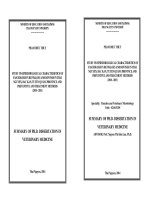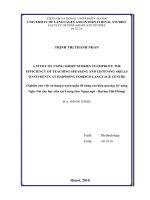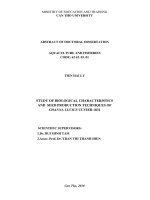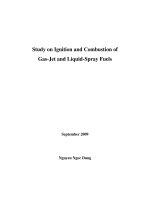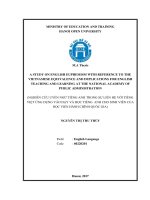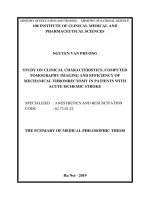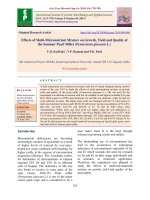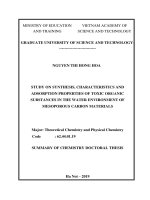Experimental and modeling study on effects of N2 and CO2 on ignition characteristics of methane/air mixture
Bạn đang xem bản rút gọn của tài liệu. Xem và tải ngay bản đầy đủ của tài liệu tại đây (1.5 MB, 13 trang )
Journal of Advanced Research (2015) 6, 189–201
Cairo University
Journal of Advanced Research
ORIGINAL ARTICLE
Experimental and modeling study on effects
of N2 and CO2 on ignition characteristics
of methane/air mixture
Wen Zeng
a,*
, Hongan Ma a, Yuntao Liang b, Erjiang Hu
c
a
School of Aerospace Engineering, Shenyang Aerospace University, Liaoning, Shenyang 110136, PR China
State Key Laboratory of Coal Mine Safety Technology, Shenyang Branch of China Coal Research Institute, Liaoning, Shenyang
110016, PR China
c
State Key Laboratory of Multiphase Flow in Power Engineering, Xi’an Jiaotong University, Shanxi, Xi’an 710049, PR China
b
A R T I C L E
I N F O
Article history:
Received 12 October 2013
Received in revised form 6 January 2014
Accepted 6 January 2014
Available online 13 January 2014
Keywords:
Gas explosion
Ignition delay
Chemical shock tube
Simulation
Sensitivity analysis
A B S T R A C T
The ignition delay times of methane/air mixture diluted by N2 and CO2 were experimentally
measured in a chemical shock tube. The experiments were performed over the temperature
range of 1300–2100 K, pressure range of 0.1–1.0 MPa, equivalence ratio range of 0.5–2.0 and
for the dilution coefficients of 0%, 20% and 50%. The results suggest that a linear relationship
exists between the reciprocal of temperature and the logarithm of the ignition delay times.
Meanwhile, with ignition temperature and pressure increasing, the measured ignition delay
times of methane/air mixture are decreasing. Furthermore, an increase in the dilution coefficient
of N2 or CO2 results in increasing ignition delays and the inhibition effect of CO2 on methane/
air mixture ignition is stronger than that of N2. Simulated ignition delays of methane/air mixture using three kinetic models were compared to the experimental data. Results show that
GRI_3.0 mechanism gives the best prediction on ignition delays of methane/air mixture and
it was selected to identify the effects of N2 and CO2 on ignition delays and the key elementary
reactions in the ignition chemistry of methane/air mixture. Comparisons of the calculated ignition delays with the experimental data of methane/air mixture diluted by N2 and CO2 show
excellent agreement, and sensitivity coefficients of chain branching reactions which promote
mixture ignition decrease with increasing dilution coefficient of N2 or CO2.
ª 2014 Production and hosting by Elsevier B.V. on behalf of Cairo University.
Introduction
* Corresponding author. Tel.: +86 2489723722;
2489723720.
E-mail address: (W. Zeng).
Peer review under responsibility of Cairo University.
Production and hosting by Elsevier
fax:
+86
Gas explosion always exists in the coal mining. Gas explosion
will form a detonation wave and produce a large amount of
catastrophic gases, which will damage the roadway and equipments and cause a large number of miners’ casualties [1–6].
The reaction kinetics of gas explosion has been experimental and numerical studied [7–11] and the effects of inert gas on
the combustion characteristics of the methane/air mixture in
2090-1232 ª 2014 Production and hosting by Elsevier B.V. on behalf of Cairo University.
/>
190
W. Zeng et al.
Fig. 1
Experimental apparatus of the chemical shock tube.
gas explosion have been reported recently [12–14]. Hu et al.
[15] numerically studied the effects of diluents (N2 and CO2)
on the laminar burning velocity of the premixed methane/air
flames. Stone et al. [16] investigated the effects of CO2 on
the laminar-burning velocity of methane/air mixtures for
variations in unburnt gas temperature (within the range of
293–454 K) and pressures (within the range of 0.5–10.4 bar).
Konnov and Dyakov [17] experimental measured the propagation speed of adiabatic flames of methane/oxygen/CO2, and
the effects of CO2 on the propagation speed of methane/air
mixtures were presented. The effects of N2 on the combustion
characteristics of methane/air mixture in gas explosion were
reported by Liang et al. [18]. They found that the laminar
flame propagation velocity, laminar combustion velocity,
markstein length, flame stability and the maximum combustion pressure decreased distinctly with the dilution coefficient
of N2 increasing. Furthermore, when the dilution coefficient
of N2 in the gas mixture was over 20%, the flame would be
unstable and was easy to exterminate. However, as the first
stage in the process of gas explosion (which consists of four
stages: ignition, laminar burning, explosive burning and deflagration), the effect of inert gas on the ignition characteristics of
the methane/air mixture in gas explosion is little reported.
The shock tube is an ideal device for investigating the ignition delays of hydrocarbon fuels although there are many
other experimental devices [19,20]. Lifshitz et al. [21] examined
the ignition of methane/oxygen mixtures highly diluted with
argon in a reflected shock tube. Their measurements covered
a temperature range of 1500–2150 K at pressure varying from
2 to 10 atm for mixture equivalence ratios of 0.5–2.0. Huang
et al. [22] conducted a series of shock tube experiments to measure the ignition delays of homogeneous methane/air mixtures
at moderate temperatures (1000–1350 K) and elevated pressures (16–40 atm). The equivalence ratios of their test mixtures
were varied from 0.7 to 1.3. Zhang et al. [23] experimentally
studied the ignition delays of methane/hydrogen mixtures with
the mole fraction of hydrogen in this mixture varying from 0%
to 100% in a chemical shock tube.
This work presents the effects of N2 and CO2 on the ignition characteristics of methane/air mixture in a chemical shock
tube over the temperature range of 1300–2100 K, pressure
range of 0.1–1.0 MPa and equivalence ratio range of 0.5–2.0
through experiment and simulation. Meanwhile, sensitivity
analysis is made to identify the effects of N2 and CO2 on the
key elementary reactions in the ignition chemistry of methane/air mixture. Experimental and simulated results are used
to explain the inhibition mechanism of inert gas on methane/
air mixture ignition in gas explosion.
Experimental
Fig. 1 shows the experimental apparatus of the chemical shock
tube. This chemical shock tube has been detailed described in
the previous studies [24,25]. Zhang et al. [24] used this facility
to measure the ignition delays of methane/air/argon mixtures,
and comparisons show good agreement between their studies
and the previous experimental studies [21,26]. The cross section of the main body of this chemical shock tube is
130 mm · 80 mm, and the wall thickness is 10 mm. Double
PET diaphragms separate the shock tube into a 4 m long
driver section and a 5.3 m long driven section. PET diaphragms are burst by pressurizing the driver with He
(>99.99% purity)/N2 (>99.99% purity) mixed gas to generate
shock waves. The detailed descriptions of this experimental
Fig. 2a Pressure and CH* chemiluminescence signals in the
ignition process of methane/air mixture.
191
10
4
10
4
10
3
10
10
2
3
τign / us
τign / us
Effects of N2 and CO2 on methane/air mixture ignition
φ = 0.5
10
P=0.1MPa
P=0.3MPa
1
2
10
φ = 1.0
P=0.1MPa
P=0.3MPa
1
10
P=0.5MPa
P=0.5MPa
P=1.0MPa
P=1.0MPa
(a)
10
(b)
0
0.5
0
0.6
0.7
0.8
10
0.5
0.6
τign / us
0.7
0.8
103T-1 / K-1
103T-1 / K-1
10
4
10
3
10
2
φ = 2.0
10
P=0.1MPa
P=0.3MPa
1
P=0.5MPa
P=1.0MPa
(c)
10
0
0.5
0.6
0.7
103T-1 /
Fig. 2b
0.8
K-1
Ignition delay times of methane/air mixture.
device and the experimental principle have been presented by
Zhang et al. [24]. The uncertainty of experimental temperature
behind the reflected shock waves is about 30 K in this study,
and the effect of the boundary layer on the typical pressure rise
rate is 4%/ms (dp/dt).
The ignition delay time (sign) in this study is defined as the
time interval between the arrival of the reflected shock wave
and the onset of ignition at the side-wall observation location
(20 mm from the end-wall). The arrival of the reflected shock
wave is marked by the step rise in pressure, while the onset of
ignition is defined using the extrapolation of the maximum slope
in observed CH\ chemiluminescence signal to the baseline.
Example pressure and CH\ chemiluminescence profiles are
shown in Fig. 2a. At this condition (p = 0.1 MPa,
T = 1735 K and / = 1.0), sign of methane/air mixture is 178 ls.
Results and discussion
Ignition delays of methane/air mixtures diluted with N2 and
CO2 (the dilution coefficient is 0%, 20% and 50%, respectively) are measured. Detailed compositions of test mixtures
in this study are given in Table 1.
The formula of dilution coefficient (/r) is
/r ¼
Vdiluent
Vfuel þ VðO2 þ3:762N2 Þ þ Vdiluent
ð1Þ
Ignition delays of methane/air mixture
In this paper, ignition delay times of methane/air mixture are
measured over the temperature range of 1300–2100 K, pressure range of 0.1–1.0 MPa and equivalence ratio range of
0.5–2.0. The maximum and minimum measured ignition delay
times of this mixture at each condition are presented in
Table 2.
Fig. 2b illustrates the measured ignition delays of methane/
air mixture over pressure range of 0.1–1.0 MPa and for equivalence ratios of 0.5, 1.0 and 2.0.
From Fig. 2b we can see that a linear relationship exists between the reciprocal of temperature and the logarithm of the
ignition delay times, according with the Arrhenius-type correlation, and an increase in ignition temperature results in a decrease in the measured ignition delay time. Fig. 2b also
illustrates ignition delays of this mixture are decreasing with
192
W. Zeng et al.
Compositions of the test mixtures in this study.
Table 1
Mixtures
Dilution coefficient
XCH4 (%)
XO2 (%)
XN2 (%)
1
2
3
0%
4.99
9.50
17.36
19.95
19.00
17.36
75.06
71.5
65.28
0.0
0.0
0.0
0.5
1.0
2.0
4
5
6
20% (N2)
3.99
7.60
13.89
15.96
15.20
13.89
80.05
77.2
72.22
0.0
0.0
0.0
0.5
1.0
2.0
7
8
9
20% (CO2)
3.99
7.60
13.89
15.96
15.20
13.89
60.05
57.2
52.22
10
11
12
50% (N2)
2.49
4.75
8.68
9.98
9.50
8.68
87.53
85.75
82.64
13
14
15
50% (CO2)
2.49
4.75
8.68
9.98
9.50
8.68
37.53
35.75
32.64
Table 2
XCO2 (%)
/
20
20
20
0.5
1.0
2.0
0.0
0.0
0.0
0.5
1.0
2.0
50
50
50
0.5
1.0
2.0
Max and min ignition delay times of methane/air mixture (p = 0.1–1.0 MPa, / = 0.5–2.0).
/
P (atm)
T (K)
sign (ls)
/
P (atm)
T (K)
sign (ls)
/
P (atm)
T (K)
sign (ls)
1.0
1.0
1.0
1.0
1.0
1.0
1.0
1.0
1.1
1.04
2.78
2.8
5.01
4.81
10.06
9.21
1924.0
1513.4
1821.1
1461.0
1756.3
1443.0
1718.3
1351.2
47
937
45
788
49
681
38
873
0.5
0.5
0.5
0.5
0.5
0.5
0.5
0.5
1.04
0.92
2.99
2.88
4.97
4.8
9.8
9.2
1897.2
1490.8
1751.8
1384.8
1822.0
1406.8
1662.4
1334.9
55
919
56
1163
29
809
50
941
2.0
2.0
2.0
2.0
2.0
2.0
2.0
2.0
1.11
0.97
3.11
3.03
5.19
5.11
10.5
9.92
1830.1
1556.3
1728.6
1460.0
1765.9
1412.4
1661.6
1326.2
70
597
60
763
41
653
43
967
Fig. 3a
Pressure and CH* chemiluminescence signals in the ignition process of methane/air mixture diluted by N2.
increasing ignition pressure. This can be explained by using the
Arrhenius-type correlation,
sign ¼ A Á pa /b XcO2 exp
Ea
RT
validation, correlation formulas for the ignition delays and
pressure at / = 0.5, 1.0 and 2.0 are obtained by linear regression analysis and the results are shown as follows:
ð2Þ
/ ¼ 0:5 : sign ¼ 1:31 Â 10À3 Â pÀ0:68 Â eð167;945=ðRTÞÞ
ð3Þ
Generally, the pressure exponential a gives the negative value for the typical hydrocarbon fuel, which indicates that ignition delay decreases with the increase in pressure. For
/ ¼ 1:0 : sign ¼ 1:28 Â 10À3 Â pÀ0:65 Â eð169;690=ðRTÞÞ
ð4Þ
/ ¼ 2:0 : sign ¼ 1:03 Â 10À3 Â pÀ0:7 Â eð171;020=ðRTÞÞ
ð5Þ
Effects of N2 and CO2 on methane/air mixture ignition
193
104
10
4
10
3
10
2
10
1
10
0
φ =0.5 P = 0.1MPa
φ =0.5 P = 1.0MPa
τign / us
τign / us
103
102
0% diluent gas
10
0% diluent gas
20% N2
1
50% N2
(a)
100
20% N2
50% N2
(b)
0.5
0.55
0.6
103T-1 /
0.65
0.7
0.5
0.6
φ =1.0 P = 0.1MPa
φ =1.0 P = 1.0MPa
10
τign / us
τign / us
103
102
3
102
0% diluent gas
0% diluent gas
20% N2
101
20% N2
101
50% N2
50% N2
(d)
(c)
0
0.5
0.6
103T-1 /
Fig. 3b
Table 3
0.8
104
104
10
0.7
103T-1 / K-1
K-1
0.7
10
0
0.6
0.7
0.8
103T-1 / K-1
K-1
Ignition delays of methane/air mixture diluted by N2.
Max and min ignition delay times of methane/air mixture diluted by N2 (/r = 50%).
/
P (atm)
T (K)
sign (ls)
/
P (atm)
T (K)
sign (ls)
/
P (atm)
T (K)
sign (ls)
1.0
1.0
1.0
1.0
1.0
1.06
0.95
4.85
4.72
9.54
2027.7
1587.5
1784.0
1495.5
1734.0
45
892
63
748
64
1.0
0.5
0.5
0.5
0.5
9.48
1.01
0.98
4.8
4.95
1423.4
1966.8
1508.9
1798.1
1469.7
922
50
1324
41
801
0.5
0.5
2.0
2.0
9.95
9.48
0.98
0.94
1737.2
1415.5
2087.8
1646.5
42
957
43
810
Eqs. (3)–(5) show that sign has pressure dependence of pÀ0.68,
pÀ0.65 and pÀ0.7 at / = 0.5, 1.0 and 2.0, respectively, and all
of the exponents of p are negative. Meanwhile, the global activation energy of the mixture is 167.95 · 103, 169.69 · 103 and
171.02 · 103 (J/mol) at / = 0.5, 1.0 and 2.0, respectively, indicating that increasing / has little effect on the global activation
energy of this mixture.
Ignition delays of methane/air mixture diluted by N2
The typical pressure and CH\ chemiluminescence signals in the
ignition process of methane/air mixture diluted by N2
(/r = 20% and 50%) at p = 0.1 MPa and / = 1.0 are shown
in Fig. 3a. The maximum and minimum measured ignition delay times of this mixture with /r = 50% are also presented in
Table 3.
Fig. 3b illustrates the measured ignition delays of methane/
air mixture diluted by N2 with /r is 20% and 50%, respectively. A linear relationship also exists between the reciprocal
of temperature and the logarithm of the ignition delay times
of methane/air mixture diluted by N2. An increase in the dilution coefficient of N2 from 0% to 20%, then to 50%, results in
increasing of the ignition delays of methane/air mixture.
Correlation formulas for the ignition delay time with p and
/ at /r = 0%, 20% and 50% are obtained by linear regression
analysis and the results are shown as follows:
194
W. Zeng et al.
Fig. 4a
Pressure and CH* chemiluminescence signals in ignition process of methane/air mixture diluted by CO2.
4
104
10
φ =0.5 P = 0.1MPa
φ =0.5 P = 1.0MPa
3
3
10
τign / us
τign / us
10
2
10
102
0% diluent gas
0% diluent gas
1
20% CO2
10
20% CO2
101
50% CO2
(a)
50% CO2
(b)
0
10
0.45
0.5
0.55
0.6
0.65
100
0.7
0.6
103T-1 / K-1
10
φ =1.0 P = 0.1MPa
φ =1.0 P = 1.0MPa
3
3
10
τign / us
10
102
2
10
0% diluent gas
0% diluent gas
20% CO2
101
20% CO2
1
10
50% CO2
(c)
100
0.8
4
104
τign / us
0.7
103T-1 / K-1
50% CO2
(d)
0
0.5
0.55
0.6
103T-1 / K-1
Fig. 4b
0.65
0.7
10
0.6
0.7
103T-1 / K-1
Ignition delays of methane/air mixture diluted by CO2.
0.8
Effects of N2 and CO2 on methane/air mixture ignition
Table 4
195
Max and min ignition delay times of methane/air mixture diluted by CO2 (/r = 50%).
/
P (atm)
T (K)
sign (ls)
/
P (atm)
T (K)
sign (ls)
/
P (atm)
T (K)
sign (ls)
1.0
1.0
1.0
1.0
1.0
1.2
1.06
5.47
4.94
10.74
1985.1
1686.9
1797.9
1499.2
1798.1
70
558
66
1082
51
1.0
0.5
0.5
0.5
0.5
9.88
1.16
0.97
5.37
4.96
1491.5
2070.0
1667.7
1912.4
1497.7
829
47
537
29
634
0.5
0.5
2.0
2.0
10.19
9.62
1.32
1.28
1726.1
1456.1
1984.1
1701.8
63
582
80
476
/r ¼ 0% : sign ¼ 1:36 Â 10À3 Â pÀ0:68 Â /0:01 Â eð168;028=ðRTÞÞ
ð6Þ
/r ¼ 20% : sign ¼ 0:91 Â 10À3 Â pÀ0:71 Â /0:32 Â eð178;499=ðRTÞÞ
becomes stronger with /r increasing. Meanwhile, the global activation energy of the mixture is 168.03 · 103, 178.5 · 103 and
186.56 · 103 (J/mol) at /r = 0%, 20% and 50%, respectively,
indicating that an increase in the dilution coefficient results in
increasing of the global activation energy of this mixture.
ð7Þ
Ignition delays of methane/air mixture diluted by CO2
/r ¼ 50% : sign ¼ 0:72 Â 10À3 Â pÀ0:69 Â /0:43 Â eð186;560=ðRTÞÞ
ð8Þ
Eq. (6) shows that the exponents of / is 0.01, which indicates sign
has little dependence on equivalence ratio at /r = 0%. With /r
increasing from 0% to 50%, the exponent of / is increasing,
indicating that the dependence of the ignition delays on /
The typical pressure and CH\ chemiluminescence signals in the
ignition process of methane/air mixture diluted by CO2
(/r = 20% and 50%) at p = 0.1 MPa and / = 1.0 are shown
in Fig. 4a. The maximum and minimum measured ignition delay times of this mixture with /r = 50% are also presented in
Table 4.
104
104
φ =0.5 P = 0.1MPa
φ =0.5 P = 1.0MPa
3
10
τign / us
τign / us
103
102
102
0% diluent gas
0% diluent gas
50% N2
1
10
10
50% CO2
(a)
100
0.45
50% N2
1
50% CO2
(b)
0.5
0.55
103T-1 /
0.6
0.65
100
0.7
0.6
104
φ =1.0 P = 1.0MPa
103
τign / us
103
102
102
0% diluent gas
10
0.8
K-1
104
φ =1.0 P = 0.1MPa
τign / us
0.7
103T-1 /
K-1
0% diluent gas
50% N2
1
10
50% CO2
(c)
100
50% CO2
(d)
0.5
0.6
103T-1 /
Fig. 5
50% N2
1
K-1
0.7
100
0.6
0.7
103T-1 /
K-1
Comparisons of the effect of N2 and CO2 on ignition delays of methane/air mixture (/r = 50%).
0.8
196
W. Zeng et al.
104
104
φ = 1.0 P = 1.0MPa
φ = 1.0 P = 0.1MPa
GRI_3.0 mech
GRI_3.0 mech
NUI_Galway mech
3
10
USC_2.0 mech
τign / us
τign / us
10
102
101
NUI_Galway mech
3
USC_2.0 mech
102
101
(b)
(a)
100
0.5
0.55
0.6
0.65
100
0.5
0.7
0.6
103T-1 / K-1
0.8
104
104
P = 0.1MPa φ = 0.5
P = 0.1MPa φ = 2.0
GRI_3.0 mech
GRI_3.0 mech
NUI_Galway mech
103
NUI_Galway mech
3
10
USC_2.0 mech
τign / us
τign / us
0.7
103T-1 / K-1
102
USC_2.0 mech
102
101
101
(d)
(c)
100
0.5
0.55
0.6
0.65
0.7
100
0.5
0.55
103T-1 / K-1
Fig. 6
0.6
103T-1 /
0.65
0.7
K-1
Measured and calculated ignition delays for methane/air mixture using different kinetic models.
Fig. 4b illustrates the measured ignition delays of methane/
air mixture diluted by CO2 with /r is 20% and 50%, respectively. A linear relationship also exists between the ignition
temperature and the ignition delay times of methane/air mixture diluted by CO2. Meanwhile, an increase in the dilution
coefficient of CO2 from 0% to 20%, then to 50%, also results
an increase in the ignition delays of methane/air mixture.
Correlation formulas for the ignition delay time with p and
/ at /r = 20% and 50% are obtained by linear regression
analysis and the results are shown as follows:
/r ¼ 20% : sign ¼ 1:71 Â 10À3 Â pÀ0:74 Â /0:26 Â eð171;851=ðRTÞÞ
coefficients of N2 and CO2 are 50%. From Fig. 5 we can see
that ignition delays of methane/air mixture diluted by CO2
are longer than that of N2 diluted at /r = 50%. However, with
the equivalence ratio of methane/air mixture increases from 0.5
to 1.0, the discrepancy of the effects of N2 and CO2 on ignition
delays of methane/air mixture becomes smaller. Furthermore,
it is noteworthy that the lines for methane/air mixture
diluted by N2 and CO2 (/r = 50%) at / = 0.5 will be crossed
at low ignition temperatures, which suggests that the
discrepancy of the effects of N2 and CO2 on ignition delays
also becomes smaller at low ignition temperatures and lean
mixture.
ð9Þ
Numerical predictions
/r ¼ 50% : sign ¼ 1:84 Â 10À3 Â pÀ0:71 Â /0:29 Â eð177;003=ðRTÞÞ
ð10Þ
Comparisons of the effects of N2 and CO2 on ignition delays of
methane/air mixture
Fig. 5 illustrates comparisons of the effects of N2 and CO2 on
ignition delays of methane/air mixture with the dilution
The ignition delay times of the methane/air mixture calculated
by different reaction mechanisms are different although at the
same conditions, as described by Zhang et al. [23]. Therefore,
in this paper, the ignition delay times of the methane/air mixture calculated by different reaction mechanisms are compared
firstly, and a reasonable reaction mechanism is selected to analyze the effect of inert gas on ignition delays of the methane/air
mixture.
Effects of N2 and CO2 on methane/air mixture ignition
10
4
10
3
10
2
10
1
197
104
φ =1.0 P = 1.0MPa
3
10
τign / us
τign / us
φ =1.0 P = 0.1MPa
102
20% N2 experimental data
20% N2 experimental data
101
50% N2 experimental data
50% N2 experimental data
20% N2 GRI_3.0 mech
20% N2 GRI_3.0 mech
50% N2 GRI_3.0 mech
50% N2 GRI_3.0 mech
(a)
10
(b)
0
0.4
0.5
0.6
100
0.5
0.7
0.6
0.8
104
104
P = 0.1MPa φ =0.5
P = 0.1MPa φ =2.0
103
τign / us
103
τign / us
0.7
103T-1 / K-1
103T-1 / K-1
102
102
20% N2 experimental data
1
20% N2 experimental data
101
50% N2 experimental data
10
50% N2 experimental data
20% N2 GRI_3.0 mech
20% N2 GRI_3.0 mech
50% N2 GRI_3.0 mech
50% N2 GRI_3.0 mech
(c)
100
0.5
(d)
0.55
0.6
0.65
0.7
103T-1 / K-1
Fig. 7a
100
0.45
0.5
0.55
0.6
0.65
0.7
103T-1 / K-1
Measured and calculated ignition delays for methane/air mixture diluted by N2.
Mechanism selection
The ignition delay times of the methane/air mixture calculated
by three reaction mechanisms e.g. GRI_3.0 mechanism [27],
USC_2.0 mechanism [28], and NUI_Galway mechanism (includes 118 species and 663 reactions) [29] are compared with
the experimental data at the same conditions, as shown in
Fig. 6. All calculated ignition delays are made using the
CHEMKIN-PRO program. GRI_3.0 mechanism includes 53
species and 325 reactions, and applied ranges of this reaction
mechanism are T = 1000–2500 K, p = 0.1–1.0 MPa and /
= 0.1–5.0. USC_2.0 mechanism was developed from
GRI_3.0 mechanism, and extra includes H2/CO optimal model
[30], C-2 reaction model [31], C-3 reaction model based on oxidation and pyrolysis of C3H6 [32], and C-4 reaction model
based on oxidation and pyrolysis of 1–3-C4H6. This reaction
mechanism includes 111 species and 784 reactions.
From Fig. 6, we can see that GRI_3.0 mechanism can well
predict the ignition delays of methane/air mixture at / = 0.5,
1.0 and p = 0.1, 1.0 MPa, while the calculated results by the
other two kinetic models are different from experimental data.
It is noteworthy that all kinetic models over-predict the
ignition delays at / = 2.0 and p = 0.1 MPa. Recent studies
[33] showed that the discrepancy between experiments and
simulations was from the uncertain elementary reaction rate
constant, and the ignition delay was limited by local ignition
and different facility. This suggests that the current kinetic
models need further modifications under wide conditions to
simulate the ignition delays of rich methane/air mixture.
Comparison with experiments
Through the above comparative analyses, the GRI_3.0 reaction mechanism is selected to analyze the ignition delay times
of the methane/air mixtures diluted by N2 and CO2.
Comparisons of calculated ignition delays of methane/air
mixture diluted by N2 and CO2 and the measured data are
shown in Figs. 7a and 7b. From these two figures we can see
that the calculated ignition delays of methane/air mixture diluted by N2 and CO2 with /r = 50% agree well with experimental data. When the dilution coefficients of N2 and CO2 are 20%,
discrepancies exist between the calculated ignition delays and
experimental data at some conditions. However, this discrepancy is within the experimental uncertainty limits (±10%).
198
W. Zeng et al.
4
4
10
10
φ =1.0 P = 0.1MPa
φ =1.0 P = 1.0MPa
3
3
10
τign / us
τign / us
10
2
10
2
10
20% CO2 experimental data
20% CO2 experimental data
1
10
1
10
50% CO2 experimental data
50% CO2 experimental data
20% CO2 GRI_3.0 mech
20% CO2 GRI_3.0 mech
50% CO2 GRI_3.0 mech
50% CO2 GRI_3.0 mech
(a)
(b)
0
0
10
0.45
0.5
0.55
0.6
103T-1 /
0.65
10
0.7
0.5
0.6
10
P = 0.1MPa φ =0.5
P = 0.1MPa φ =2.0
3
103
τign / us
10
102
2
10
20% CO2 experimental data
1
10
20% CO2 experimental data
1
10
50% CO2 experimental data
50% CO2 experimental data
20% CO2 GRI_3.0 mech
20% CO2 GRI_3.0 mech
50% CO2 GRI_3.0 mech
50% CO2 GRI_3.0 mech
(c)
(d)
0
0
10
0.45
0.5
0.55
0.6
0.65
10
0.45
0.7
0.5
103T-1 / K-1
Fig. 7b
0.6
0.65
103T-1 / K-1
T
T
30000
R155
Normalized Sensitivity
R38
R156
R119
R53
60000
0.55
Measured and calculated ignition delays for methane/air mixture diluted by CO2.
90000
Normalized Sensitivity
0.8
4
104
τign / us
0.7
103T-1 / K-1
K-1
30000
0
R155
R38
R156
R119
R158
20000
10000
0
-10000
-30000
(a)
-60000
0.000745
0.00075
Time/s
Fig. 8a
(b)
R158
0.000755
0.00076
-20000
0.00154
R53
0.00156
0.00158
Time/s
Effects of N2 on the sensitivity coefficients of the key reactions (a: /r = 0%, b: /r = 50%).
0.7
Effects of N2 and CO2 on methane/air mixture ignition
T
90000
R38
R155
R38
R156
R119
R53
60000
T
9000
Normalized Sensitivity
Normalized Sensitivity
199
30000
0
-30000
R155
R156
R119
R53
6000
3000
0
-3000
(a)
-60000
(b)
R158
0.000745
0.00075
0.000755
0.00076
Time/s
Fig. 8b
0.0018
R158
0.0019
0.002
0.0021
Time/s
Effects of CO2 on the sensitivity coefficients of the key reactions (a: /r = 0%, b: /r = 50%).
Sensitivity analysis
Sensitivity analysis is always used to illustrate the key reactions
in the reaction mechanism which will promote or inhibit the
combustible mixture ignition, and it also helps to further
understand the chemical kinetic characteristics in the process
of ignition. The detailed descriptions of sensitivity analysis
have been presented by Vlachos [34].
The sensitivity analysis is conducted for methane/air mixture diluted by N2 and CO2 using the GRI_3.0 mechanism
to analyze the effect of inert gas on ignition delays in this
study.
Fig. 8a shows the sensitivity coefficients of some key reactions in the ignition process of methane/air mixture at /
= 1.0, p = 0.1 MPa and T = 1540 K. The dominant reactions
promoting methane/air mixture ignition are:
R155 : CH3 þ O2 () O þ CH3 O
R38 : H þ O2 () O þ OH
R156 : CH3 þ O2 () OH þ CH2 O
R119 : HO2 þ CH3 () OH þ CH3 O
The dominant reactions inhibiting methane/air mixture
ignition are:
R158 : CH3 þ CH3 ðþMÞ () C2 H6 ðþMÞ
R53 : H þ CH4 () CH3 þ H2
Generally, the auto-ignition of combustible mixture is more
sensitive to small radicals because the fuel and large radicals
are mainly consumed to form small radicals by dissociation.
The free radicals such as H, O and OH are extremely active
and short-lived during the process of ignition. The chainbranching and chain-propagating reactions initiated by the
free radicals play the most important role in the chemical
reaction, as described by Zhang et al. [24,25]. There is O or
OH radical formed in R155, R38, R156 and R119, so
these reactions will promote methane/air mixture to ignition.
In addition, the key ignition inhibition reactions are the chain
termination reaction R158 and the consumption reactions of
methane R53.
Figs. 8a and 8b shows the effects of N2 and CO2 on the sensitivity coefficients of these key reactions at / = 1.0,
p = 0.1 MPa, T = 1540 K and /r = 50%. The sensitivity
coefficients of these key reactions promoting ignition decrease
greatly as methane/air mixture diluted by N2 and CO2, leading
to the weakening on accelerated ignition tendency. Furthermore, with methane/air mixture diluted by CO2, the sensitivity
coefficients of these key ignition promotion reactions decrease
greater than that of the mixture diluted by N2. That is to say,
comprised with N2, the inhibition effect of CO2 on methane/air
mixture ignition is greater and this is consistent to the experimental results in Fig. 5. N2 and CO2 are chemically passive
agents, and they have passive influences on methane/air mixture ignition at two aspects: thermal effect and chemical kinetic
effect. With the dilution coefficients of N2 and CO2 increasing,
the concentration of the fuel will be decreased (as shown in Table 1), leading to the decrease in the total heat value, and will
prolong the ignition delay time of methane/air mixture at the
same p, T and / (compared the results in Figs. 3a and 3b of
this paper with the results in Fig. 3 of Zhang et al. [24]). N2
has been constantly treated as non reactive bulk gas which
does not participate in ignition and combustion. However,
CO2 is a major product of combustion while it is chemically
passive as well. Adding CO2 into fuel/air system may possibly
influence the chemical kinetics and thus the ignition delay. CO2
modifies the ignition kinetics in two main ways. First, the reverse of the reaction, CO þ OH () CO2 þ H, decreases the
H atom concentration and weakens the ignition. Second, dilution with CO2 results in an overall stronger third-body efficiency of the mixture than dilution with N2.
Fig. 8c gives the effects of N2 and CO2 on the sensitivity
coefficients of these key reactions at p = 0.1 MPa,
T = 1540 K and / = 0.5, 1.0, 2.0, respectively. From Fig. 8c
we can see that the values of sensitivity coefficients of these
key ignition promotion reactions reach maximum at /
= 1.0, which implies the strongest promotion effect on ignition at the stoichiometric equivalence ratio. Furthermore, at
200
W. Zeng et al.
R158
R53
R119
R156
R38
R155
(a) φ =0.5
R158
R53
R119
R156
R38
R155
(b) φ =1.0
(1) A linear relationship exists between the reciprocal of
temperature and the logarithm of the ignition delay
times, and an increase in ignition temperature or pressure results in a decrease in ignition delay time of methane/air mixture.
(2) An increase in the dilution coefficient of N2 or CO2
results in increasing ignition delays and the inhibition
effect of CO2 on methane/air mixture ignition is stronger
than that of N2.
(3) Simulated ignition delays of methane/air mixture using
three kinetic models including USC_2.0 mechanism,
GRI_3.0 mechanism and NUI_Galway mechanism were
compared to the experimental data show that GRI_3.0
mechanism gives the best prediction on ignition delay
times of the methane/air mixture.
(4) Comparisons of the calculated ignition delays with the
experimental data of methane/air mixture diluted by
N2 and CO2 show excellent agreement, and sensitivity
analysis shows that ignition delays of methane/air
mixture are more sensitive to the small radicals such
as H, O and OH. Sensitivity coefficients of ignition
promotion reactions decrease with increasing dilution
coefficients of N2 and CO2. This inhibits the total
reaction rate and increases the ignition delays of
methane/air mixture.
As discussed above, the inhibition effects of N2 and CO2 on
methane/air mixture ignition (as the first stage in gas explosion) are greater, and the inhibition effect becomes significant
with dilution coefficient increased.
R158
R53
Conflict of interest
R119
The authors have declared no conflict of interest.
R156
Compliance with Ethics Requirements
R38
This article does not contain any studies with human or animal
subjects.
R155
(c) φ =2.0
Fig. 8c Comparisons of the effects of N2 and CO2 on sensitivity
coefficients of the key reactions.
each equivalence ratio, the sensitivity coefficients of these key
ignition promotion reactions decrease as methane/air mixture
diluted by N2 and CO2, and the inhibition effect of CO2 on
methane/air mixture ignition is greater than that of N2 and this
is also consistent to the experimental results in Fig. 5.
Conclusions
The ignition delays of methane/air mixture diluted by N2 and
CO2 with dilution coefficients varying from 0% to 50% were
experimentally measured and simulated in a chemical shock
tube over the temperature range of 1300–2100 K, the pressure
range of 0.1–1.0 MPa, and for equivalence ratios of 0.5, 1.0
and 2.0. Following conclusions are summarized.
Acknowledgement
The authors appreciate the financial support from the National Natural Science Foundation of China (51376133).
References
[1] Troiani G. Effect of velocity inflow conditions on the stability of
a CH4/air jet-flame. Combust Flame 2009;156:539–42.
[2] Razus DM, Krause U. Comparison of empirical and semiempirical calculation methods for venting of gas explosions. Fire
Safety J 2001;36:1–23.
[3] Hirano T. Gas explosions caused by gasification of condensed
phase combustibles. J Loss Prevent Proc 2006;19:245–9.
[4] Hirano T. Methodology for case studies of an accidental gas
explosions. J Loss Prevent Proc 2001;14:553–7.
[5] Maremonti M, Russo G, Salzano E, Tufano V. Numerical
simulation of gas explosions in linked vessels. J Loss Prevent
Proc 1999;12:189–94.
[6] Chen ZY, Zhang YJ, Chou CL, Li Y, Wang ZH, Ge YT, Zheng
CG. Trace element emissions from spontaneous combustion of
Effects of N2 and CO2 on methane/air mixture ignition
[7]
[8]
[9]
[10]
[11]
[12]
[13]
[14]
[15]
[16]
[17]
[18]
[19]
[20]
gob piles in coal Mines, Shanxi, China. Int J Coal Geol
2008;73:52–62.
Shearer MJ, Vincent HYT, Corr B. Analysis of results from
large scale hydrocarbon gas explosions. J Loss Prevent Proc
2000;13:167–73.
Ferrara G, Benedetto AD, Salzano E, Russo G. CFD analysis of
gas explosions vented through relief pipes. J Hazard Mater
2006;137:654–65.
Oh KH, Kim H, Kim JB, Lee SE. A study on the obstacleinduced variation of the gas explosion characteristics. J Loss
Prevent Proc 2001;14:597–602.
Shebeko YN, Tsarichenko SG, Korolchenko AY. Burning
velocities and flammability limits gaseous mixture at elevated
temperatures and pressure. Combust Flame 1995;102:427–37.
Bielert U, Sichel M. Numerical simulation of premixed
combustion processes in closed tubes. Combust Flame
1998;114:397–419.
Chen ZY, Tang CL, Fu J, Jiang X, Li QQ, Wei LJ, Huang ZH.
Experimental and numerical investigation on diluted DME
flames: thermal and chemical kinetic effects on laminar flame
speeds. Fuel 2012;102:567–73.
Chen ZY, Wei LJ, Huang ZH, Miao HY, Wang XB, Jiang DM.
Measurement of laminar burning velocities of dimethyl ether-air
premixed mixtures with N2 and CO2 dilution. Energy Fuels
2009;23(2):735–9.
Li QQ, Fu J, Wu XS, Tang CC, Huang ZH. Laminar flame
speeds of DMF-iso-octane-air-N2/CO2 mixtures. Energy Fuels
2012;26(2):917–25.
Hu EJ, Jiang X, Huang ZH, Iida N. Numerical study on the
effects of diluents on the laminar burning velocity of methane/
air mixtures. Energy Fuels 2012;26(2):917–25.
Stone R, Clarke A, Beckwith P. Correlations for the laminarburning velocity of methane/diluent/Air mixtures obtained in
free-fall experiments. Combust Flame 1998;114:546–55.
Konnov AA, Dyakov IV. Measurement of propagation speeds
in adiabatic cellular premixed flames of CH4 + O2 + CO2. Exp
Therm Fluid Sci 2005;29:901–7.
Liang YT, Zeng W, Hu EJ. Experimental study of the effect of
nitrogen addition on gas explosion. J Loss Prevent Proc
2013;26:1–9.
Kumar K, Sung CJ. An experimental study of the auto-ignition
characteristics of conventional jet fuel/oxidizer mixtures: Jet-A
and JP-8. Combust Flame 2010;157:676–85.
Kumar K, Sung CJ. A comparative experimental study of the
auto-ignition characteristics of alternative and conventional jet
fuel/oxidizer mixtures. Fuel 2010;89:2853–63.
201
[21] Lifshitz A, Scheller K, Burcat A, Skinner GB. Shock tube
investigation of ignition in methane/oxygen/argon mixtures.
Combust Flame 1971;16:311–21.
[22] Huang J, Hill PG, Bushe WK, Munshi SR. Shock-tube study of
methane ignition under engine-relevant conditions: experiments
and modeling. Combust Flame 2004;136:25–42.
[23] Zhang YJ, Jiang X, Wei LJ, Zhang JX, Tang CL, Huang ZH.
Experimental and modeling study on auto-ignition
characteristics of methane/hydrogen blends under engine
relevant pressure. Int J Hydrogen Energy 2012;37:19168–76.
[24] Zhang YJ, Huang ZH, Wei LJ, Zhang JX, Law CK.
Experimental and modeling study on ignition delays of lean
mixtures of methane, hydrogen, oxygen, and argon at elevated
pressures. Combust Flame 2012;159:918–31.
[25] Zhang YJ, Huang ZH, Wei LJ, Niu S. Experimental and kinetic
study on ignition delay times of ethane/hydrogen/
oxygen/nitrogen mixtures by shock tube. Chin Sci Bull
2011;56:2853–61.
[26] Petersen EL, Hall JM, Smith SD. Ignition of lean methanebased fuel blends at gas turbine pressures. J Eng Gas Turb
Power 2007;129(4):937–44.
[27] Smith GP, Golden DM, Frenklach M, Moriarty NW, Eiteneer
B, Goldenberg M. GRI-Mech 3.0; 2000.
[28] Wang H, You X, Joshi AV, Davis SG, Laskin A, Egolfopoulos
F.
USC
2.0
Mech;
2007.
< />USC_Mech_II.htm/>.
[29] Petersen EL, Kalitan DM, Simmons S, Bourque G, Curran HJ,
Simmie JM. Methane/propane oxidation at high pressures:
experimental and detailed chemical kinetic modeling. Proc
Combust Inst 2007;31:447–54.
[30] Davis SG, Joshi AV, Wang H. An optimized kinetic model of
H2/CO combustion. Proc Combust Inst 2005;30(1):1283–92.
[31] Wang H, Laskin A. A comprehensive kinetic model
of
ethylene
and
acetylene
oxidation
at
high
temperatures. Delaware: University of Delaware; 1998.
[32] Davis SG, Law CK, Wang H. Propene pyrolysis and oxidation
kinetics in a flow reactor and laminar flames. Combust Flame
1999;119(4):375–99.
[33] Dryer FL, Chaos M. Ignition of syngas/air and hydrogen/air
mixtures at low temperatures and high pressures: experimental
data interpretation and kinetic modeling implications. Combust
Flame 2008;152:293–9.
[34] Vlachos DG. Reduction of detailed kinetic mechanisms for
ignition and extinction of premixed hydrogen/air flames. Chem
Eng Sci 1996;51:3979–93.

